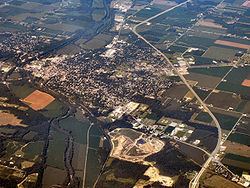Country United States Elevation 712 ft (217 m) Zip code 46992 Population 10,491 (2013) | State Indiana Time zone EST (UTC-5) Local time Thursday 12:21 PM | |
 | ||
Weather 4°C, Wind NW at 37 km/h, 90% Humidity Points of interest Paradise Spring Historical, Charley Creek Gardens, Dr James Ford Historic H, The Honeywell House | ||
Wabash is a city in Noble Township, Wabash County, in the U.S. state of Indiana. The population was 10,666 at the 2010 census. The city is the county seat of Wabash County.
Contents
Map of Wabash, IN 46992, USA
Wabash is notable as claiming to be the first electrically lighted city in the world, which was inaugurated on March 31, 1880. However, closer inspection of the reference show's only the court house grounds were lighted. It is also home to the historic Eagles Theater, Paradise Spring Treaty Grounds (1826), the Wabash and Erie Canal, Presbyterian Church (Wabash, Indiana) (1880), and Disciples of Christ Christian Church (Wabash, Indiana) (1865). A seasonal classic root-beer stand sits atop the man made geographic cut directly south of the Wabash river, and attracts locals to its traditional car-side service.
Geography
Wabash is located at 40°48′3″N 85°49′38″W (40.800799, -85.827163).
According to the 2010 census, Wabash has a total area of 9.128 square miles (23.64 km2), of which 8.89 square miles (23.02 km2) (or 97.39%) is land and 0.238 square miles (0.62 km2) (or 2.61%) is water.
History
The name Wabash derives from a Miami-Illinois term for "water over white stones." The Wabash post office has been in operation since 1839. The Miami name reflected the clarity of the river in Huntington County, Indiana where the river bottom is limestone.
On March 31, 1880, four 3,000-candle power lamps were suspended from the top of the courthouse. Two telegraph wires ran from the lamps to the courthouse basement, where they were connected to a threshing machine to provide power Wabash used a new type of carbon arc light invented by Charles Brush in 1870.
The James M. Amoss Building, Downtown Wabash Historic District, East Wabash Historic District, First Christian Church, Honeywell Memorial Community Center, Honeywell Studio, McNamee-Ford House, North Wabash Historic District, West Wabash Historic District, and Solomon Wilson Building are listed on the National Register of Historic Places.
2010 census
As of the census of 2010, there were 10,666 people, 4,465 households, and 2,805 families residing in the city. The population density was 1,199.8 inhabitants per square mile (463.2/km2). There were 5,068 housing units at an average density of 570.1 per square mile (220.1/km2). The racial makeup of the city was 96.3% White, 0.4% African American, 1.0% Native American, 0.5% Asian, 0.6% from other races, and 1.2% from two or more races. Hispanic or Latino of any race were 2.0% of the population.
There were 4,465 households of which 29.3% had children under the age of 18 living with them, 45.7% were married couples living together, 12.5% had a female householder with no husband present, 4.7% had a male householder with no wife present, and 37.2% were non-families. 32.6% of all households were made up of individuals and 14.9% had someone living alone who was 65 years of age or older. The average household size was 2.31 and the average family size was 2.88.
The median age in the city was 41.3 years. 22.5% of residents were under the age of 18; 7.9% were between the ages of 18 and 24; 24.7% were from 25 to 44; 26.4% were from 45 to 64; and 18.8% were 65 years of age or older. The gender makeup of the city was 47.2% male and 52.8% female.
2000 census
As of the census of 2000, there were 11,743 people, 4,799 households, and 3,100 families residing in the city. The population density was 1,319.0 people per square mile (509.4/km²). There were 5,136 housing units at an average density of 576.9 per square mile (222.8/km²). The racial makeup of the city was 96.85% White, 0.37% African American, 1.06% Native American, 0.51% Asian, 0.03% Pacific Islander, 0.41% from other races, and 0.77% from two or more races. Hispanic or Latino of any race were 1.46% of the population.
There were 4,799 households out of which 29.2% had children under the age of 18 living with them, 49.6% were married couples living together, 11.1% had a female householder with no husband present, and 35.4% were non-families. 30.9% of all households were made up of individuals and 13.4% had someone living alone who was 65 years of age or older. The average household size was 2.36 and the average family size was 2.95.
In the city, the population was spread out with 24.3% under the age of 18, 9.0% from 18 to 24, 27.4% from 25 to 44, 22.9% from 45 to 64, and 16.4% who were 65 years of age or older. The median age was 37 years. For every 100 females there were 91.0 males. For every 100 females age 18 and over, there were 87.3 males.
The median income for a household in the city was $12,000, and the median income for a family was $14000. Males had a median income of $18000 versus $12,000 for females. The per capita income for the city was $18,210. About 7.9% of families and 9.3% of the population were below the poverty line, including 12.5% of those under age 18 and 8.8% of those age 65 or over.
